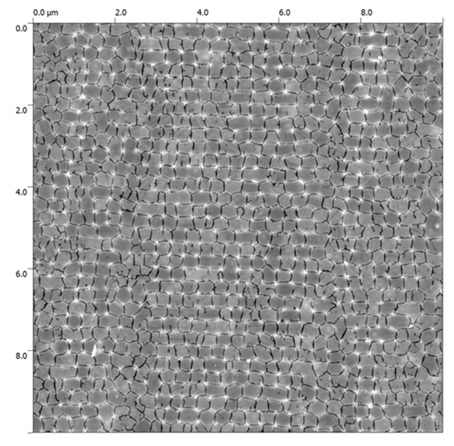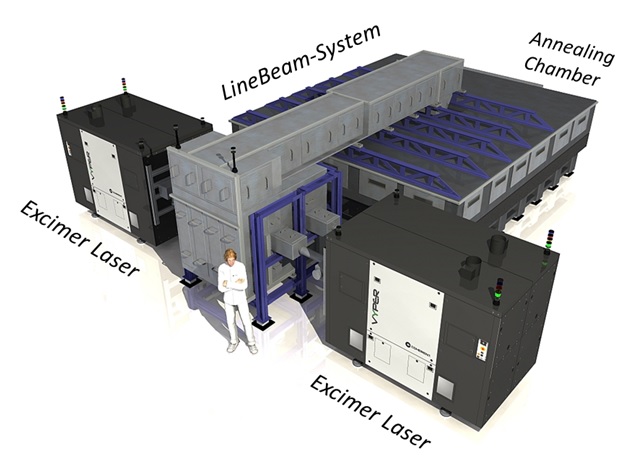June 20, 2014
Demand is rising for high-definition and power-efficient low-temperature polysilicon or LTPS backplanes being the foremost differentiator for mobile display devices such as smartphones and tablets. Excimer laser annealing is the enabling technology to mass manufacture industrial-grade LTPS backplanes on very large substrate panels.
Dr. Ralph Delmdahl
In the digital age, our information- and knowledge society relies heavily on mobile display devices which have become nothing less than windows to the world. Their advanced touch screen displays are made up of countless pixels which carry the digital information content. The more pixels, the more information can be displayed. Full-HD resolution has already become the mainstream for smartphones corresponding to two million pixels crammed together on an area as small as some 10 square inches. The ongoing trend of steadily increasing pixel densities goes along with shrinking pixel size and likewise with decreasing thin-film transistor (TFT) dimensions. Pixel densities above and beyond 300 ppi are no longer supported by conventional TFTs made of amorphous silicon material chiefly due to its limited carrier mobility. Thus, the transition to the enabling low-temperature polysilicon (LTPS) material exhibiting an over 200 times better carrier mobility and a much more stable switching behavior is mandatory for high resolution mobile displays. As opposed to their amorphous counterparts, LTPS-TFTs can be made some ten times smaller supporting denser pixels and letting more backlight pass through a display. As a consequence, power consumption for backlighting can be reduced. Plus, the polycrystalline high mobility material supports driver circuitry to be integrated on the display itself thereby reducing the number of connections and enabling a narrow display bezel.
The demand for higher resolution and longer battery life in smartphones and tablets will continue. LTPS capacity expansion at the leading panel makers is ongoing with a clear focus on shifting from generation 4 (680mm x 880mm) to the many times larger generation 6 (1,500mm x 1,800mm) and generation 8 (2,200 mm x 2,600 mm) substrates. It is the groundbreaking Vyper/LineBeam technology which enables the required large-format excimer laser annealing process of transforming amorphous silicon panels into high-grade LTPS panels.
Technically, a 308nm excimer laser line beam is scanned over the substrate with the amorphous silicon layer on top, which absorbs the UV radiation. Remnant seeds of solid silicon are the starting point for transforming the molten layer from amorphous to polycrystalline silicon. (Fig.1). This recrystallization process is known as excimer laser annealing. On account of the short UV wavelength and the short laser pulse duration in the nanosecond regime the energy of the line beam focus is selectively applied to the some 50 nm thin silicon layer leaving the glass substrate below thermally unaffected. The result of this low temperature process is a highly ordered LTPS film with approximately 0.3 µm x 0.3 µm grain size providing a carrier mobility of some 200 cm²/Vs which is two orders of magnitude above the the electron mobility of conventional amorphous silicon panels (Fig.2).

(Fig.2). Atomic force microscopy image of an etched LTPS film on display glass
The high power 308 nm VYPER excimer laser provides pulse repetition rates up to 600 Hz and stabilized output power up to 2,400 W. Fed into the LineBeam optical delivery system the result is a homogeneous excimer laser line beam with on-substrate dimensions up to 1,300 mm x 0.4 mm capable of fast, large-format generation 6 and generation 8 LTPS panel processing.
The maximum throughput of today’s most advanced Vyper/LineBeam production systems is about 30,000 square meters of LTPS per month - equivalent to the size of five soccer pitches and sufficient for some four million 5-inch Full-HD displays.
Process scale-up of excimer laser annealing - for many years limited to small size substrates and manufactured in scarce quantities for niche applications - was made possible by the unique Vyper/LineBeam system concept which hinges on its multi-oscillator design with each of the laser oscillators delivering 600 W average power and 1 Joule pulse energy. A patented high voltage switching device ensures temporally synchronized light pulse emission of the oscillators with an accuracy of some 2 ns. In a Vyper/LineBeam-1300 system, a number of four 600 W oscillators, provided by two dual-beam Vyper lasers jointly operate to create a combined power of 2,400 W. The four oscillator beams enter the LineBeam optical delivery system separately and will successively be mixed, expanded and superimposed. Finally, the spatially combined line shaped beam of 1,300 mm length is projected onto the substrate which is secured inside the annealing chamber (Fig.3).

(Fig.3). Principle sketch of a Vyper/LineBeam-1300 LTPS production system with integrated annealing chamber
This laser-optical multi-core architecture can, in principle, be further extended to leverage the cumulative power of more than four oscillators, leaving room for further line length and likewise fixed-cost productivity scaling.
Over the course of the last four years way over 100 Vyper/LineBeam systems with 750 mm line length and beyond have been shipped to all leading panel makers. Today they provide the global production capacity of LTPS backplanes representing the vital ingredient of the soaring share of razor-sharp and battery-saving mobile displays.
Author
Dr. Ralph Delmdahl is Product Marketing Manager of Coherent in Göttingen. He is responsible for driving the excimer laser and UV-optical systems business.
Contact
ralph.delmdahl@coherent.com
www.coherent.com/excimer











